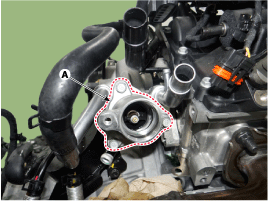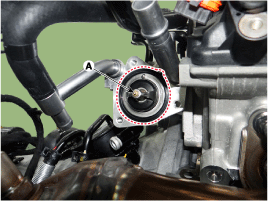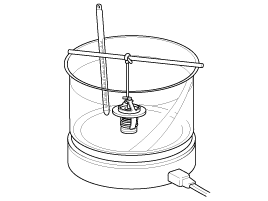Hyundai Genesis: Cooling System / Thermostat Repair procedures
Hyundai Genesis (DH) 2013-2016 Service Manual / Engine Mechanical System / Cooling System / Thermostat Repair procedures
| Removal and Installation |
Removal of the thermostat will have an adverse effect, leading to lowered cooling efficiency.
Do not remove the thermostat, even if the engine tends to overheat. |
| 1. |
Disconnect the battery "-" terminal from the trunk room. |
| 2. |
Drain engine coolant so its level is below thermostat.
(Refer to Cooling System - "Coolant") |
| 3. |
Remove the water inlet pipe.
(Refer to Cooling System - "Water Temperature Control Assembly") |
| 4. |
Remove the coolant inlet fitting (A).
|
| 5. |
Remove the thermostat (A).
|
| 6. |
To install, reverse the removal procedure. |
| Inspection |
| 1. |
Immerse the thermostat in water and gradually heat the water.
|
| 2. |
Check the valve opening temperature.
If the valve opening temperature is not as specified, replace the thermostat. |
| 3. |
Check the valve lift.
If the valve lift is not as specified, replace the thermostat. |
 Thermostat Components and Components Location
Thermostat Components and Components Location
Components
1. Water temperature control Assembly2. Thermostat3. Coolant inlet fitting
...
 Thermostat Troubleshooting
Thermostat Troubleshooting
Troubleshooting
SymptomsPossible CausesRemedyCoolant leakage
•
From the thermostat gasket
Check the mounting bolts
•
Check the torque of the mounting bolts
•
Retighten the bo ...
Other information:
Hyundai Genesis (DH) 2013-2016 Owners Manual: Seat Belt – Passenger’s 3-point system with convertible locking retractor
This type of seat belt combines the features of both an emergency locking retractor seat belt and an automatic locking retractor seat belt. Convertible retractor type seat belts are installed in the rear seat positions to help accommodate the installation of child restraint systems. Al ...
Hyundai Genesis (DH) 2013-2016 Service Manual: Camshaft Position Sensor (CMPS) Description and Operation
Description Camshaft Position Sensor (CMPS) is a hall sensor and detects the camshaft position by using a hall element. It is related with Crankshaft Position Sensor (CKPS) and detects the piston position of each cylinder which the CKPS can't detect. The two CMPS are installed engine head c ...
© 2013-2025 www.hgenesisdh.com




